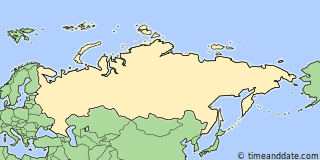Time Zones Currently Being Used in Russia
| Offset | Time Zone Abbreviation & Name | Example City | Current Time | |
|---|---|---|---|---|
| UTC +2 | EET | Eastern European Time | Kaliningrad | Thu, 03:54:29 |
| UTC +3 | MSK | Moscow Standard Time | Moscow | Thu, 04:54:29 |
| UTC +4 | SAMT | Samara Time | Samara | Thu, 05:54:29 |
| UTC +5 | YEKT | Yekaterinburg Time | Yekaterinburg | Thu, 06:54:29 |
| UTC +6 | OMST | Omsk Standard Time | Omsk | Thu, 07:54:29 |
| UTC +7 | KRAT | Krasnoyarsk Time | Krasnoyarsk | Thu, 08:54:29 |
| NOVT | Novosibirsk Time | Novosibirsk | Thu, 08:54:29 | |
| UTC +8 | IRKT | Irkutsk Time | Irkutsk | Thu, 09:54:29 |
| UTC +9 | YAKT | Yakutsk Time | Chita | Thu, 10:54:29 |
| UTC +10 | VLAT | Vladivostok Time | Vladivostok | Thu, 11:54:29 |
| UTC +11 | MAGT | Magadan Time | Magadan | Thu, 12:54:29 |
| SAKT | Sakhalin Time | Yuzhno-Sakhalinsk | Thu, 12:54:29 | |
| SRET | Srednekolymsk Time | Srednekolymsk | Thu, 12:54:29 | |
| UTC +12 | ANAT | Anadyr Time | Anadyr | Thu, 13:54:29 |
| PETT | Kamchatka Time | Petropavlovsk-Kamchatsky | Thu, 13:54:29 | |
How Many Time Zones Are There in Russia?
With its 11 local times, Russia is one of the countries with the most time zones worldwide. While France and its dependencies stretch across 12 time zones, Russia holds another world record: 10 of the country's 11 time zones cover a contiguous landmass—only the Russian exclave of Kaliningrad, wedged between Lithuania and Poland, breaks that pattern.
Russia has not observed Daylight Saving Time (DST) since it was abolished in 2011.
Time Zone History of Russia
Before time zones were introduced in Russia, each location in the country observed its own solar time. The first move to standardize time in Russia was in 1880, when Moscow Mean Time was introduced in and around Moscow. Based on the solar time at Moscow's longitude, it was 2 hours, 30 minutes, and 17 seconds ahead of Greenwich Mean Time (GMT), which was then the world's time standard.
In other parts of the country, cities still observed their own solar time until 1919, when the country was officially divided into several time zones. The local time in each time zone was now determined on the basis of GMT.
Decree Time
In 1930, following a period with several time zone shifts, clocks in all time zones were uniformly turned forward by 1 hour, effectively establishing year-round DST across the Soviet Union. This measure, referred to as Decree Time, was intended to save energy.
During the 1980s, a growing number of regions abolished Decree Time, and in 1991, it was revoked across the entire country. However, it was soon reinstated in many areas. For example, the standard time in Moscow changed from UTC+3 to UTC+2 in 1991—only to be returned to UTC+3 in 1992. Decree Time also remains in force in some of the Soviet Union's former republics.
Recent Time Zone Changes
After the dissolution of the Soviet Union, Russia reshuffled its time zone boundaries a number of times. In 2011, both Decree Time and seasonal clock changes were officially abolished across the nation. Instead, Russia observed permanent DST—until 2014, when the country returned to year-round standard time.

Time Zone News
- 28/02/2024 – DST Start in Europe 2024
- 02/10/2023 – End of DST in Europe 2023
- 24/03/2023 – DST Start in Europe 2023
- 30/09/2022 – End of DST in Europe 2022
- 14/02/2022 – DST Start in Europe 2022
More Information
- Time Zone Converter
- Meeting Planner
- Event Time Announcer/Fixed Time
- Time Zone Abbreviations
- Time Zone News
- Daylight Saving Time
Time Zone Map

